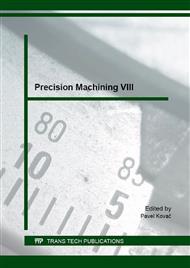p.100
p.108
p.114
p.119
p.125
p.131
p.137
p.143
p.149
Performance of Norton Quantum Grinding Wheels
Abstract:
This paper deals with cutting ability of progressive Norton Quantum grinding wheel during grinding roll bearing steel 100Cr6 of hardness 61 HRC. Cutting ability of this wheel is compared with conventional grinding wheel and based on measurement of grinding forces as well as surface roughness. Results of experiments show that Norton Quantum grinding wheels are capable of long term grinding cycles at high removal rates without unacceptable occurrence of grinding chatter and surface burn whereas application of conventional wheel can produce excessive vibration and remarkable temper colouring of ground surface. Moreover, while Norton Quantum grinding wheel gives nearly constant grinding forces and surface roughness within ground length at higher removal rates, conventional grinding wheel (as that reported in this study) does not.
Info:
Periodical:
Pages:
125-130
Citation:
Online since:
February 2016
Authors:
Keywords:
Price:
Сopyright:
© 2016 Trans Tech Publications Ltd. All Rights Reserved
Share:
Citation:


